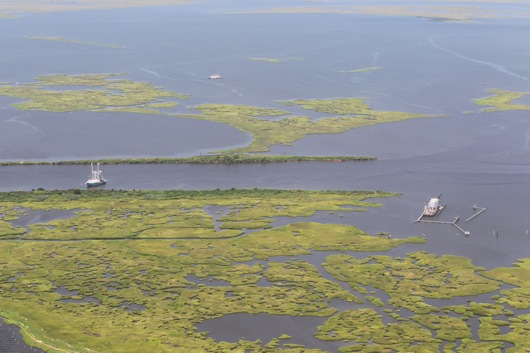The Spill From Above
A picture is worth a thousand words. The expression may sound cliche, but in the conservation movement, it couldn’t be more true. In the day and age of quick soundbites and short attention spans, when it comes to promoting a cause, grabbing people’s attention is key. We need more than just hearing about things in order to care; we need to see them, and we need to be moved.
That’s one of the main reasons that pilot Tom Hutchings takes visitors to the Gulf of Mexico up in the air in his Cessna 182, knowing very well the visual power of seeing this environmental catastrophe from above. In the weeks following the Deepwater Horizon explosion, oil covered the diverse marsh landscape of the Mississippi Delta, turning a pristine habitat into an alien environment.
Hutchings flies for South Wings, a non-profit with a tagline of “conservation through aviation.” Founded in 1996, the organization is committed to connects conservation groups with pilots, providing flights at no cost.
“Do you get motion sick?” Hutchings ask as he works to take off a back hatch on the Cessna so our videographer can film through it as we fly.
“Not really,” I respond, not completely sure what I’m getting myself into. As I stare into the small cockpit wondering how I am going to cram my legs in, I realize I actually have no idea what I’m about to take on. This is my first aerial photography tour, something that I’ve always wanted to do, but never had the opportunity.
We load into the small plane and make our way down the runway, slowly lifting into the air and leaving the urban landscape of New Orleans behind. “All the waterways that you see that are straight are manmade,” Hutchings points out. And there are a lot of straight waterways. From above it’s pretty clear why levy failure during Hurricane Katrina had such an impact; this city is surrounded by water.
Soon we’re in the heart of the Mississippi Delta, flying over small islands and marshes. These days, there is in fact less oil visible to the human eye. Gone are the days when entire bays were covered in a reflective slick, but the oil’s presence and destruction is still ever present. Marshes are lined with a reddish color, evidence of oil soaked sand. In a couple of places, thin long lines of oil streak the blue water, almost as if painted on. In protected bays, oil collects and doesn’t move. As Hutchings points out, stormy weather blows it in, and there’s no way to get it out.
But it’s not just the destruction that gets to me; it’s the natural beauty. Blue water dotted with bright green marshes. Natural designs created from the various waterways. From the moment that we start flying over this diverse and rich natural landscape, it’s apparent how unique and sensitive it is; to storms, to oil and to people.
“Disaster tourism” is what some people deem projects that take travelers to areas that have seen some kind of catastrophe or devastation. Yet when you travel to a place and see it first hand, you quickly realize how connected you are to that place.
In the Gulf of Mexico, it’s apparent that even being from the Northwest, this is my backyard. It’s hard not to get emotional as I fly over this amazing place, thinking about how I would feel if a similar disaster were to happen to the natural spaces that I call home. Tears well up as I continue snapping photos, trying to capture the scope and colors of what passes below me.
“Did you even think about the Gulf of Mexico before this oil spill?” Hutchings asks me.
I think for a second. I’m embarrassed by my answer: “no, not really.” And it’s true. Besides having looked at it on the map, I realize that I’ve never really given a second thought to this region’s culture, environment and economy. But it’s a region that works its way into all of our lives, from goods that get transported up the Mississippi, to seafood that’s shipped all over the country to jazz music.
I realize that it’s all this that we’re trying to capture in photos and with video. That’s a big order. But it must be done, or we will never contemplate what our everyday actions have on people and regions outside of our immediate circles. And that’s why Hutchings continues to fly, and we have to continue to pay attention.
By Anna Brones
Aerial Tour from Uncage the Soul Productions on Vimeo.
Full gallery of photos here.
























1 COMMENT
Really appreciate the effort for this video and the pilot’s observations. It is such a small area but tells a big story. Thank you!
Leave a comment